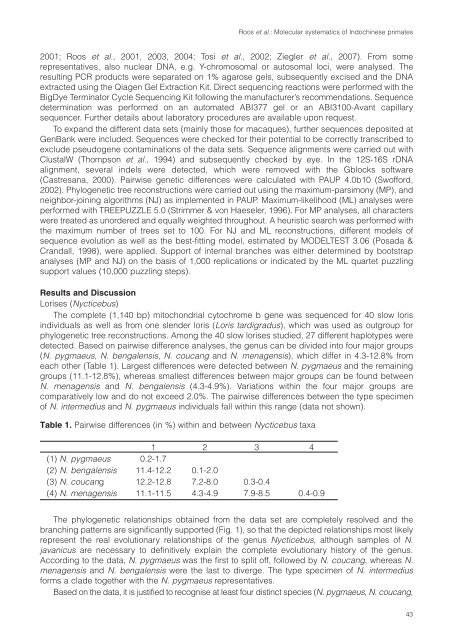Vietnamese Journal of Primatology - Frankfurt Zoological Society
Vietnamese Journal of Primatology - Frankfurt Zoological Society
Vietnamese Journal of Primatology - Frankfurt Zoological Society
You also want an ePaper? Increase the reach of your titles
YUMPU automatically turns print PDFs into web optimized ePapers that Google loves.
Roos et al.: Molecular systematics <strong>of</strong> Indochinese primates<br />
2001; Roos et al., 2001, 2003, 2004; Tosi et al., 2002; Ziegler et al., 2007). From some<br />
representatives, also nuclear DNA, e.g. Y-chromosomal or autosomal loci, were analysed. The<br />
resulting PCR products were separated on 1% agarose gels, subsequently excised and the DNA<br />
extracted using the Qiagen Gel Extraction Kit. Direct sequencing reactions were performed with the<br />
BigDye Terminator Cycle Sequencing Kit following the manufacturer’s recommendations. Sequence<br />
determination was performed on an automated ABI377 gel or an ABI3100-Avant capillary<br />
sequencer. Further details about laboratory procedures are available upon request.<br />
To expand the different data sets (mainly those for macaques), further sequences deposited at<br />
GenBank were included. Sequences were checked for their potential to be correctly transcribed to<br />
exclude pseudogene contaminations <strong>of</strong> the data sets. Sequence alignments were carried out with<br />
ClustalW (Thompson et al., 1994) and subsequently checked by eye. In the 12S-16S rDNA<br />
alignment, several indels were detected, which were removed with the Gblocks s<strong>of</strong>tware<br />
(Castresana, 2000). Pairwise genetic differences were calculated with PAUP 4.0b10 (Sw<strong>of</strong>ford,<br />
2002). Phylogenetic tree reconstructions were carried out using the maximum-parsimony (MP), and<br />
neighbor-joining algorithms (NJ) as implemented in PAUP. Maximum-likelihood (ML) analyses were<br />
performed with TREEPUZZLE 5.0 (Strimmer & von Haeseler, 1996). For MP analyses, all characters<br />
were treated as unordered and equally weighted throughout. A heuristic search was performed with<br />
the maximum number <strong>of</strong> trees set to 100. For NJ and ML reconstructions, different models <strong>of</strong><br />
sequence evolution as well as the best-fitting model, estimated by MODELTEST 3.06 (Posada &<br />
Crandall, 1998), were applied. Support <strong>of</strong> internal branches was either determined by bootstrap<br />
analyses (MP and NJ) on the basis <strong>of</strong> 1,000 replications or indicated by the ML quartet puzzling<br />
support values (10,000 puzzling steps).<br />
Results and Discussion<br />
Lorises (Nycticebus)<br />
The complete (1,140 bp) mitochondrial cytochrome b gene was sequenced for 40 slow loris<br />
individuals as well as from one slender loris (Loris tardigradus), which was used as outgroup for<br />
phylogenetic tree reconstructions. Among the 40 slow lorises studied, 27 different haplotypes were<br />
detected. Based on pairwise difference analyses, the genus can be divided into four major groups<br />
(N. pygmaeus, N. bengalensis, N. coucang and N. menagensis), which differ in 4.3-12.8% from<br />
each other (Table 1). Largest differences were detected between N. pygmaeus and the remaining<br />
groups (11.1-12.8%), whereas smallest differences between major groups can be found between<br />
N. menagensis and N. bengalensis (4.3-4.9%). Variations within the four major groups are<br />
comparatively low and do not exceed 2.0%. The pairwise differences between the type specimen<br />
<strong>of</strong> N. intermedius and N. pygmaeus individuals fall within this range (data not shown).<br />
Table 1. Pairwise differences (in %) within and between Nycticebus taxa<br />
1 2 3 4<br />
(1) N. pygmaeus 0.2-1.7<br />
(2) N. bengalensis 11.4-12.2 0.1-2.0<br />
(3) N. coucang 12.2-12.8 7.2-8.0 0.3-0.4<br />
(4) N. menagensis 11.1-11.5 4.3-4.9 7.9-8.5 0.4-0.9<br />
The phylogenetic relationships obtained from the data set are completely resolved and the<br />
branching patterns are significantly supported (Fig. 1), so that the depicted relationships most likely<br />
represent the real evolutionary relationships <strong>of</strong> the genus Nycticebus, although samples <strong>of</strong> N.<br />
javanicus are necessary to definitively explain the complete evolutionary history <strong>of</strong> the genus.<br />
According to the data, N. pygmaeus was the first to split <strong>of</strong>f, followed by N. coucang, whereas N.<br />
menagensis and N. bengalensis were the last to diverge. The type specimen <strong>of</strong> N. intermedius<br />
forms a clade together with the N. pygmaeus representatives.<br />
Based on the data, it is justified to recognise at least four distinct species (N. pygmaeus, N. coucang,<br />
43
















